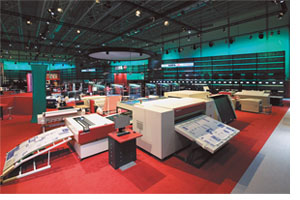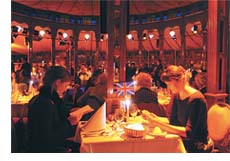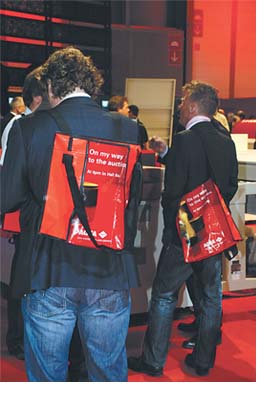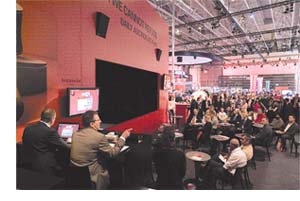  drowning sailor knows no enemies. In fact, he or she accepts help from just about anywhere, be it a life raft, a helicopter, or even a piece of driftwood bobbing by. But in 2008, when Agfa Graphics N.V. was struggling to stay afloat, it got a little persnickety about its liberators. drowning sailor knows no enemies. In fact, he or she accepts help from just about anywhere, be it a life raft, a helicopter, or even a piece of driftwood bobbing by. But in 2008, when Agfa Graphics N.V. was struggling to stay afloat, it got a little persnickety about its liberators.
Based in Mortsel, Belgium, the provider of digital printers and pre-press systems and products was facing myriad problems, including everything from lingering financial woes to rumors it would soon be sold. But seeing its presence at Drupa 2008, an enormous 14-day printing expo held in Dusseldorf, Germany, as an opportunity to bail out the floundering company, Ronald Marien, Agfa's director of marketing communications, made an absurdly lofty promise.
Marien guaranteed the company's bean counters that his exhibit program wouldn't only help Agfa survive amid a roiling sea of problems; it would generate a whopping $58.5 million
in additional revenue during the show, including $53.7 million in pre-planned purchases plus another $4.8 million above and beyond those anticipated sales. His plan: Completely ignore the vast majority of the show's 385,000-plus attendees.
Not surprisingly, internal stakeholders at Agfa baulked at this radical strategy. After all, who in their right mind would try to keep the lion's share
of attendees out of their booth, especially when the company needed financial rescuing from anyone and anywhere it could get it? But given Marien's demonstrated marketing prowess and sky-high goals, and with the responsibility for the program's success positioned firmly on his shoulders, they reluctantly acquiesced to his seemingly unrealistic approach.
Titanic Troubles
Truth be told, Marien's plucky plan wasn't merely an attempt to plump up the company's dwindling reserves. It was also a clever way to send a message to upper management.
"I wanted to prove that exhibit marketing doesn't cost a company anything," Marien says. "Done right, it's not a cost driver; it's a revenue driver - one that can help rather than hinder an ailing bottom line. And to prove it, I told management, 'You can increase or decrease my budget however you want, and I'll still make sure you get the best exhibit and marketing plan possible to help your salespeople close pre-planned sales. But on top of that, I'm going to put something in place that will generate revenue over and above those pre-planned contract signings.'"
 Unfortunately, Marien hadn't a clue how exactly to deliver on his self-imposed, arguably unattainable objectives when he made that bold promise. But when Drupa opened on May 29, 2008, his "something" had evolved into a buyers-only booth strategy that focused almost all of Agfa's marketing funds and attention on a mere 0.5 percent of the show's total audience - 2,000 targeted attendees who were existing customers or prospects that verbally expressed plans to purchase within six months of the show. Unfortunately, Marien hadn't a clue how exactly to deliver on his self-imposed, arguably unattainable objectives when he made that bold promise. But when Drupa opened on May 29, 2008, his "something" had evolved into a buyers-only booth strategy that focused almost all of Agfa's marketing funds and attention on a mere 0.5 percent of the show's total audience - 2,000 targeted attendees who were existing customers or prospects that verbally expressed plans to purchase within six months of the show.
Marien's "bean-counter bashing" certainly put a cheeky grin on his face, but it was born of serious financial problems involving everything from rising material costs to expensive product launches. Agfa Graphics (hereafter referred to as Agfa) is one of three business groups, along with Agfa Healthcare and Agfa Materials, under the corporate umbrella of Agfa-Gevaert N.V. Together, the companies develop, produce, and distribute analog- and digital-imaging systems and IT solutions for the printing industry, the health-care sector, and several industrial applications.
During the last decade, the three companies switched the bulk of their products from analog to digital, a process that required large cash outlays with little immediate return. Meanwhile, Agfa had to keep pace with the graphics industry, which meant developing a new line of inkjet printers. Though the line launched in 2005, significant delays in development and unexpected startup costs pushed its break-even date to 2010.
To make matters worse, the price of raw materials such as silver and aluminum - which comprise 60 percent of the cost of Agfa-Gevaert's products - skyrocketed in the last five years. That forced the company to increase the price of its offset plates drastically. Since Agfa press owners have to purchase these plates or shut down their presses, they were understandably frustrated with the unavoidable price increase.
Not surprisingly, then, Agfa-Gevaert's stock prices plummeted. But perhaps even more alarming was that shareholders, employees, and customers lost faith in the company. And in the months leading up the show, rumors that Agfa would soon be sold were running rampant in the industry.
 So while Agfa had exhibited at Drupa for more than 30 years and had always been a market leader, the 2008 show's objectives were significantly different than in years past. This time, Agfa needed not only to generate sales and awareness for its new inkjet line, which meant differentiating itself from giant competitors and exhibit-hall neighbors such as Canon Inc. and Hewlett-Packard Development Co. L.P., it also So while Agfa had exhibited at Drupa for more than 30 years and had always been a market leader, the 2008 show's objectives were significantly different than in years past. This time, Agfa needed not only to generate sales and awareness for its new inkjet line, which meant differentiating itself from giant competitors and exhibit-hall neighbors such as Canon Inc. and Hewlett-Packard Development Co. L.P., it also
had to stem the company's financial hemorrhage by generating the maximum number of at-show sales. But above all else, if Agfa were to survive and thrive in the future, it would need to placate angry customers, rebuild their faith in the company, and squelch industry rumors that Agfa was for sale to the highest bidder.
Pre-Show Disruptions
Facing more problems than Bernie Madoff, Marien did what he usually does: exactly the opposite of what most people expect. "I'm a big believer in 'disruptive marketing,'" he says. "When you've got big problems, you do the opposite of the expected. Faced with rumors about their companies, most marketers ignore them or launch fact-based campaigns to try to dispel them. I decided to reinforce them to the point of being ridiculous. That way, we demystified the rumors and made the people spreading them look absurd."
Teaming up with his exhibit house, Gielissen Interiors and Exhibitions of Eindhoven, The Netherlands, Marien hatched a two-fold plan to snuff out the rumors and generate revenue to boot. First, to make good on Marien's promise of "something" to generate $4.8 million in revenue, the team decided Agfa would hold an in-booth product auction at 4 p.m. every day. They hoped the auction would generate a sort of buying frenzy to encourage both typical Agfa customers and buyers loyal to other brands to make an at-show purchase of Agfa's products.
Second, their daily in-booth auction strategy featured a spot-on tagline, "Make us an offer we cannot refuse," to reinforce industry rumors and draw curious buyers to the daily sale. Paired with little more than Agfa's logo and contact information along with an image of an auctioneer's gavel and sound block, the tagline appeared in pre-show promotions and on at-show graphics and giveaway bags. After attendees discovered the true meaning of the tagline - that Agfa was selling products and not the company - the clever strategy became a wrench in the rumor mill, eventually grinding it to a halt.
In the weeks leading up to the show, the minimalist "Make us an offer we cannot refuse" message appeared in full-page ads in trade magazines. But to support Marien's buyers-only strategy, the ad was noticeably void of the company's booth number.
"We focused all of our money and effort on our top 2,000 customers and prospects," Marien says. "We needed to woo these serious buyers far more than anyone else, smoothing any ruffled feathers and ensuring that they talked to us at the show. Attendees outside of these 2,000 top buyers were merely tourists, and we didn't need to see them."
 So aside from the somewhat-evasive ads, Agfa refrained from any mass-marketing tactics. Instead, individual salespeople and sales teams used personal mailers, letters, phone calls, e-mails, and prescheduled in-booth appointments and demos to ensure that their customers and top prospects visited the booth. So aside from the somewhat-evasive ads, Agfa refrained from any mass-marketing tactics. Instead, individual salespeople and sales teams used personal mailers, letters, phone calls, e-mails, and prescheduled in-booth appointments and demos to ensure that their customers and top prospects visited the booth.
Tourist-Free Zone
At the show, that "no tourists" approach was first evidenced by Agfa's booth location. While Drupa organizes all related printing firms within one of its 17 show halls, Marien opted for what most exhibitors would consider the worst space in the joint.
"I picked the space as far away from the central entrance as possible, and in a corner bordered on three sides by the venue's walls," Marien says. "Since we only wanted to talk to qualified buyers, and our salespeople were using personal communications with those people to make sure they knew where we were and what we were offering, I didn't want any tourists wandering into the booth. So I made it hard for them to find us. Only serious buyers seeking us out would discover where we were, and everyone else would self select out of the process."
The booth space - an oblong 300-by-1,000-foot behemoth - was similar in size to that of Agfa's competitors. But the exhibit's unique layout and architectural elements served as key differentiators, which further supported Marien's "no tourists" directive and helped foster a buyer schmooze fest inside.
Visitors approached the booth from a single aisle, as the exhibit's other three sides butted up against the convention center's walls. While a few narrow alleyways allowed immediate access and sightlines into the booth, the majority of the structure's front side comprised a one-of-a-kind gallery, the exterior wall of which was positioned a mere 1 foot from the aisle. Bearing little more than Agfa's logo and its corporate red and white hues, the 18-foot-tall exterior wall practically screamed "No tourists allowed!" and offered only four openings through which to pass into what Marien called the "buffer zone."
"Between the show aisle and the interior of our booth we created a buffer zone, which was like a big gallery," Marien says. "We wanted to create a unique oasis on the show floor for our most important customers. The buffer zone deterred tourists from entering our space and created a quieter and more secluded experience for our VIPs on the other side."
 Inside the buffer-zone gallery,
attendees found printed images created using Agfa's inkjet printers and paper products along with art-gallery lighting and soothing music. The buffer zone was also divided into three sections, each of which offered a slightly different experience. One section, for example, featured pictures and promotional images from a famous Belgian chocolate company, along with a distinct chocolate aroma. In another section filled with a forest
scent, cartoon-like images from a well-known Belgian artist dotted the walls, and a display stand in the middle of the space supported a sculpture from the famous florist Daniel Ost. Inside the buffer-zone gallery,
attendees found printed images created using Agfa's inkjet printers and paper products along with art-gallery lighting and soothing music. The buffer zone was also divided into three sections, each of which offered a slightly different experience. One section, for example, featured pictures and promotional images from a famous Belgian chocolate company, along with a distinct chocolate aroma. In another section filled with a forest
scent, cartoon-like images from a well-known Belgian artist dotted the walls, and a display stand in the middle of the space supported a sculpture from the famous florist Daniel Ost.
Beyond the buffer zone, the booth was diagonally bisected by an 18-foot-tall black-fabric wall that separated the public space (aka the gallery) and the VIP area (the space behind the wall comprising roughly 40 percent of the booth). While qualified buyers and the occasional misguided tourist could peruse the buffer zone and the public area, which housed the auction activities and myriad product displays, the VIP area was only open to Agfa's customers and top prospects. Here, buyers found everything from an extensive bar and lounge area with a variety of refreshments to 20 meeting rooms, in-depth demo stations, a press lounge, and more.
Throughout the space, Gielissen opted for minimal architecture, reusable and reconfigurable modular components, and cost-conscious materials to keep the budget to a bare minimum. And due to its minimal weight, fabric was the material of choice for most of the large structural components. The majority of the booth featured neutral gray, white, or black tones along with Agfa's corporate red. Rather than expensive theatrics or high-priced architectural details, Gielissen chose a relatively inexpensive LED lighting system that bathed the booth in continually changing hues.
In addition, Agfa purchased its booth furniture from a nearby Ikea, rather than renting it at Drupa, and auctioned the furniture off to employees after the show. While the strategy incurred a slight cost savings and helped the company recoup a portion of its initial investment, it was mostly a perk for employees, many of whom purchased the contemporary furniture for a fraction of its retail cost.
But the booth's dramatic and cost-effective materials weren't the only tactics that helped differentiate Agfa's exhibit from competitors' "business as
usual" exhibits. Taking the "no tourists" strategy a step further, Marien opted against promotional giveaways in the public section of the exhibit and completely outlawed collateral literature throughout the space.
 "We didn't want to tempt tourists into the space by giving out goodies," Marien says. "So we did away with giveaways in the public area. Plus, we didn't want to hand out costly literature to people that weren't ready to buy, and for those people that were interested in a purchase, we wanted them to talk with salespeople, not grab a brochure and run." So instead of printed lit, more than 100 mini kiosks featuring 21-inch plasma screens provided on-the-spot product information. When attendees approached the kiosks to access product info, staffers could easily swoop in, introduce themselves, and answer any questions. "We didn't want to tempt tourists into the space by giving out goodies," Marien says. "So we did away with giveaways in the public area. Plus, we didn't want to hand out costly literature to people that weren't ready to buy, and for those people that were interested in a purchase, we wanted them to talk with salespeople, not grab a brochure and run." So instead of printed lit, more than 100 mini kiosks featuring 21-inch plasma screens provided on-the-spot product information. When attendees approached the kiosks to access product info, staffers could easily swoop in, introduce themselves, and answer any questions.
Catering to Customers
Given the effectiveness of Marien's "no tourists" strategy, Agfa's booth was brimming with VIP customers and prospects. But many arrived with a recently acquired mistrust of the company's financial standings as well as a bee in their bonnet after being stung by Agfa's recent price increase. So Agfa and Gielissen developed several tactics to make sure VIPs left the booth feeling calm, cared for, and loyal to their new best friend.
The VIP treatment started with the info desk and an army of staffers, with no less than 10 hostesses stationed at the info desk and a whopping 330 staffers, including everyone from research-and-development specialists
to press liaisons to C-level executives, blanketing the booth. While Agfa targeted only 2,000 attendees, Marien estimated that thousands of tourists would still wander into the space despite his best efforts. Therefore, the staffing armada ensured that even with the stray tourists, VIPs would have plenty of quality time with staffers.
Prior to the show, Agfa mailed qualified local buyers an invitation to breakfast in its booth between 10 and 11 a.m. every day. Attendees arriving at the show via train or shuttle bus passed through the show's main entrance at the front of the fairgrounds. Thus, with Agfa's booth in the back of the hall, which was at the back of the fairgrounds, most people couldn't make the trek to the exhibit until noon at best. However, the show's parking lot was immediately outside of the hall in which Agfa's booth resided, which meant local attendees arriving by car would be the company's first visitors.
 After a full European breakfast, attendees received a red backpack filled with a bottle of water, piece of fruit, and slice of cake. After a full European breakfast, attendees received a red backpack filled with a bottle of water, piece of fruit, and slice of cake.
While Agfa doted on buyers from show open to close, the coddling climaxed in an after-show dinner party held every day at 6:30 p.m. in what Marien calls the "mirror tent." Yet another benefit to Marien's back-of-the-hall booth location was access to an unused portion of the adjoining parking lot. So Marien rented an antique Belgian dancing tent and positioned it in the adjacent parking lot. But this wasn't your garden-variety pop-up tent. Covering roughly 3,000 square feet and towering 30 feet tall at its peak, the tent featured a gorgeous wooden floor, stylish wooden support structures, elegant mirrors, decorative lighting, and stained-glass windows.
Every evening, caterers transformed
the space into a distinct dining experience for approximately 120 VIP buyers. One night it became an Italian ristorante, while another night it was an Asian eatery, for example. Each dinner featured a different type of food, drinks, and entertainment, so that even return visitors would never experience the same thing twice.
"Rather than sending VIPs out on the town to find a restaurant, we brought the restaurant to them, all the while building trust and stronger relationships with those clients and prospects," Marien says. In addition, to attend competing events, attendees typically had to leave the show and travel across the city to another venue. Instead, Agfa's VIPs simply headed to the company's booth at the close of the show, and after dinner, Agfa provided coaches to transport them back to their hotels. Plus, time spent with Agfa was time not spent with its competitors.
 Going Once, Going Twice Going Once, Going Twice
While Marien created a bevy of disruptive-marketing tactics, his crowning achievement was the end-of-day auction, an unexpected and unprecedented revenue generator that helped Agfa pad its pockets - and prove that exhibit marketing can generate revenue without the aid of the sales department. "Since auctioning off products, especially new ones," Marien says, "is unheard of at trade shows, it seemed like the perfect thing for us to do."
Each day at 4 p.m., roughly 100 would-be bidders gathered in the booth's auction lounge, which featured black tables and chairs for serious bidders along with plenty of space for curious onlookers to ogle the action. A central plasma screen and several smaller monitors displayed the products available for bid, and a desk positioned front and center was reserved for auctioneers from Heyman & Co. N.V., an auction house in Antwerp, Belgium.
During the auction, attendees bid on new Agfa products - each of which were featured in a printed auction schedule - along with some pop-culture items, such as lithographs from the famous Belgian artist Panamarenko and soccer jerseys autographed by Pele. While Agfa's products were the auction's main draw, Marien hoped the pop-culture items would lure the press and additional buyers to the in-booth event. Plus, to heighten attendees' interest in these items, Marien tagged them with a philanthropic lure: After the show, Agfa would donate a portion of the proceeds from the pop-culture items to the installation of a water pump in Burkina Faso.
Marien's timing was another stroke of genius. With the auction starting at
4 p.m., attendees shopping for a
bargain refrained from purchasing
competitors' products, hoping they would snag a deal at the Agfa auction. Meanwhile, staffers encouraged Agfa's
customers to make their purchases at
any time, pointing out a clause in Agfa's
at-show sales contracts indicating that if their purchased item sold at auction for less than the initial purchase price, Agfa would refund the difference. Not surprisingly, the auction and show-sale price guarantee cornered the market for all serious buyers, and angered more than a few competitors.
"Our competitors were furious with us," Marien says. "Our auction meant that most people postponed their purchases with competitors at least temporarily if not permanently. And competitors lurked around our auction to see which of their previous customers made a purchase."
With typical auction prices falling lower than market value, you'd assume that Agfa lost money on the deal. However, quite the opposite was true. "Attendees were drawn by the novelty of the auction and got excited by the fever of bidding. In fact, many made on-the-spot auction purchases that would either have gone to our competitors or might have been delayed for months," Marien says. "Plus, while a few products didn't reach the minimum price we'd set and we withdrew them from the bidding, many other products actually went for more than the average market price."
 While Marien promised Agfa management he'd deliver $4.8 million beyond the pre-arranged at-show sales, the auction actually brought in $5.3 million. In fact, the auction was so well received that the company now uses a regularly scheduled online auction to move secondhand equipment and prop up sales for new equipment that hasn't quite hit its stride. What's more, the in-booth auction drew the attention of attending journalists, who provided coverage in the Drupa Daily as well as 10 of the industry's most widely read magazines covering inkjet printers. While Marien promised Agfa management he'd deliver $4.8 million beyond the pre-arranged at-show sales, the auction actually brought in $5.3 million. In fact, the auction was so well received that the company now uses a regularly scheduled online auction to move secondhand equipment and prop up sales for new equipment that hasn't quite hit its stride. What's more, the in-booth auction drew the attention of attending journalists, who provided coverage in the Drupa Daily as well as 10 of the industry's most widely read magazines covering inkjet printers.
Agfa also shot past its goal of closing $53.7 million in pre-arranged sales at the show, actually closing $161 million in sales, almost three times its original objective. "The rate for signing deals already in the pipeline increased dramatically," Marien says. "We were able to close deals with customers that were in a sort of 'wait and see' mode, as they were looking for some sign from us that the company was financially stable. Apparently, our presence on the show floor did the trick."
Bringing in a total of $166.3 million, Agfa's unorthodox approach was actually an incredibly strategic, well-designed program. Its unexpected tactics helped Agfa not only to stand out from the crowd but also to garner dramatic results - and throw a financial lifeline to the company. And what's more, Marien's disruptive marketing is a colorful feather in the cap of almost all exhibit marketers.
"I proved that with some out-of-the-box ideas, a marketing department can generate interest, buzz, and most importantly cold hard cash without the help of the sales department." E
|
















